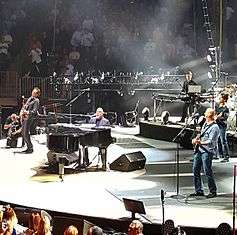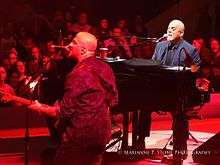Billy Joel Band
| Billy Joel Band | |
|---|---|
 Billy Joel Band performing in 2014 | |
| Background information | |
| Origin | Long Island, New York, United States |
| Genres | Rock, Pop |
| Years active | 1971–Present |
| Labels | Columbia Records, Family Productions |
| Website | billyjoel.com |
| Members |
Billy Joel Tommy Byrnes Chuck Burgi David Rosenthal Mark Rivera Crystal Taliefero Carl Fischer Andy Cichon Mike DelGuidice |
| Past members |
Richie Cannata Liberty DeVitto Doug Stegmeyer Dave Lebolt David Brown Russell Javors Jeff Bova Jeff Jacobs Patrick McDonald Larry Russell Rhys Clark Don Evans Al Hertzberg Ron Tutt Tom Whitehorse Howard Emerson Tom Wolk Rudi Dobson Schuyler Deale Mindy Jostyn Louis L. Gregory David Santos |
The Billy Joel Band is the band that backs singer-songwriter and pianist Billy Joel on both studio and live recordings. The band stabilized around 1975 but has undergone several significant lineup changes beginning in the late 1980s and early 1990s. Joel's touring band didn't begin playing on his records until he recorded the album Turnstiles in 1976. This line-up included Richie Cannata on saxophones and organ, Liberty DeVitto on drums, Russell Javors on guitar, and Doug Stegmeyer on bass.[1]
The band, which now no longer includes any of its original members, is often not recognized as a formal entity, and is instead referred to simply as Billy Joel's band.[2]
Early days
Joel's first touring band, formed in 1971 to support the Cold Spring Harbor album, comprised Rhys Clark on drums, Al Hertzberg on guitar, and Larry Russell on bass. The group toured throughout the United States and in Puerto Rico.[3]
The touring lineup changed and it took a few years for the lineup to stabilize. In an online interview, DeVitto describes how Joel's classic late 1970s-early 1980s band first came together:
Billy and I used to play the same club in Plainview, Long Island, called My House. He was 17 and in a band called The Hassles and I was 16 and in a band called The New Rock Workshop. We would watch each other play and acknowledge each other in passing. In 1974, he was living in Los Angeles and had already released Piano Man and Streetlife Serenade. He used studio musicians for the recording and different guys out on the road. I was playing in a band called Topper with Doug Stegmeyer and he got the gig to play bass with Billy on the “Streetlife” tour. [Billy] told Doug that he wanted to move back to New York and find a permanent band he could record and tour with on a regular basis. Doug recommended me because Billy was looking for a New York-type drummer, aggressive and hard hitting, and the rest is history. The three of us recorded the basic tracks for Turnstiles and we both recommended Russell Javors and Howie Emerson, who played guitars in Topper and with the addition of Richie Cannata on saxophone, the “Billy Joel Band” was born.[4]
By the late 1970s, the touring and studio lineup of Joel's band stabilized and consisted, mostly, of the following musicians:
- Billy Joel - lead vocals, piano & keyboards, guitar, harmonica
- Liberty DeVitto — drums, percussion
- Doug Stegmeyer — bass guitar, backing vocals
- Russell Javors — rhythm and lead guitars, harmonica, backing vocals
- Richie Cannata — saxophones, flute, clarinet, percussion, keyboards
- David Brown — lead guitar, backing vocals
This was the basic lineup for some of Joel's classic albums of the 1970s and 1980s including Turnstiles, The Stranger, 52nd Street, Glass Houses, and Songs in the Attic.
In 2014, Cannata, DeVitto, and Javors reunited and performed a short set of Joel's songs at the ceremony during which they were inducted into the Long Island Music Hall of Fame, (with Stegmeyer, posthumously), primarily for their work with Joel.[5] They officially formed a band, "The Lords of 52nd Street," which plays faithful renditions of the original Joel recordings.[6] David Clark of the Joel tribute band "Songs in the Attic"[7] plays piano and provides lead vocals, Ken Cino plays guitar, and Doug Kistner plays keyboards in the group.[8]
Line-up changes

From The Stranger in 1977 through The Bridge in 1986, Joel had been working with the same producer, Phil Ramone, as well as with the same basic incarnation of the Billy Joel Band (with minor line-up changes over the years). One important addition to the band in 1982 was the replacement of his long-time saxophonist Richie Cannata with Mark Rivera.[9] Joel also added the lead guitarist David Brown who stayed with the band throughout the 1980s, beginning with the recording of Glass Houses (1980). But for the 1989 album Storm Front, Joel chose a new producer, Mick Jones, and started to make more significant changes to the band.[10] At this point, the only players that Joel kept, for both his touring band and for the recording of the album, were David Brown, Mark Rivera, and Liberty DeVitto. He also added the percussionist and multi-instrumentalist Crystal Taliefero who would become a permanent fixture in his band.
For his last studio album, River of Dreams, in 1993, Joel used a new producer again (this time Danny Kortchmar). Although Joel continued to use DeVitto as his main drummer, he allowed Kortchmar to use different drummers for some of the drum tracks. Richie Cannata returned to record some of the sax parts on the record but didn't join Joel for the River of Dreams tour that followed.
At this point, the only remaining long-standing member of Joel's touring band was DeVitto. Joel also had a new lead guitarist in Tommy Byrnes (who remains Joel's touring lead guitarist and who served as both a musical consultant and band member in the Movin' Out musical). Tom "T-Bone" Wolk joined the band, just for the River of Dreams tour, playing bass guitar, as well as other instruments, including accordion. And Joel continued to retain the musicians Crystal Taliefero and Mark Rivera who both remain in his band. The 1993 River of Dreams tour saw the addition of David Rosenthal, formerly of Rainbow, on keyboards.
In August 1995, Billy Joel's long-time bassist Doug Stegmeyer, who had been let go from the band prior to the recording of 1989's Storm Front album, committed suicide in his Long Island home.[11] Stegmeyer had played on every one of Joel's albums from Turnstiles (1976) through to the live album, KOHЦEPT (1987).
For the 2006 tour, Joel did not invite DeVitto back as drummer after the two became involved in a legal dispute, and the drummer Chuck Burgi (who played in the Broadway production of Movin' Out) replaced DeVitto. For this particular tour, Cannata temporarily returned on lead saxophones though he soon left the band again and Rivera returned to his position as lead saxophonist. In 2006, Carl Fischer joined Joel's band as his trumpeter and trombonist for select songs (most notably for the trumpet solos in the song "Zanzibar").
On February 27, 2010, Joel's bassist from his "River of Dreams" tour, Tom Wolk, died from a heart attack at the age of 58.[12]
Current line-up
Billy Joel's current lineup (with the exception of DelGuidice) was featured on his 2006 album, 12 Gardens Live and on the film and recording, Live at Shea Stadium (2011). It includes the following musicians:
- Billy Joel - lead vocals, piano, keyboards, harmonica, guitar
- Tommy Byrnes - lead guitar, backing vocals
- Andy Cichon - bass guitar, backing vocals
- Dave Rosenthal - keyboards, musical director
- Chuck Burgi - drums, percussion
- Crystal Taliefero - percussion, backing vocals, saxophone, harmonica
- Mark Rivera - guitar, backing vocals, saxophone, percussion
- Carl Fischer - trumpet, trombone, saxophone
- Michael DelGuidice - guitar, backing vocals
References
- ↑ "'Turnstiles' Credits". allmusic.com. Retrieved March 30, 2015.
- ↑ A Google News archive search done in February 2010 for the period 1970 through 2009 shows 175 references to "Billy Joel Band" and 134 references to "Billy Joel's band", although the search mechanism tends to co-mingle the terms.
- ↑ Blog Interview with Liberty DeVitto
- ↑ Gamboa, Glenn (October 23, 2014). "Billy Joel Band set to join Piano Man in Long Island Music Hall of Fame". New York Newsday. Retrieved April 20, 2016.
- ↑ Filipski, Kevin (February 5, 2016). "Interview with Guitarist Russell Javors". Flipsidereviews.blogspot.com. Retrieved April 20, 2016.
- ↑ 12 Grapes (November 30, 2013). "'Songs in the Attic' featuring David Clark". Peekskill-Cortlandt Patch. Retrieved April 20, 2016.
- ↑ "The Lords of 52nd Street". Facebook. Retrieved April 20, 2016.
- ↑ Mark Rivera's Official Website Archived July 17, 2012, at the Wayback Machine.
- ↑ Shades of Grey (documentary film). 1993.
- ↑ "Ex-band Leader For Billy Joel Found Dead". Spokesman-Review. 27 August 1995. Retrieved 31 January 2012.
- ↑ Morris, Christopher (2010-03-01). ""Bassist Tom 'T-Bone' Wolk dies", 1 March 2010, Variety". Variety.com. Retrieved 2011-09-13.